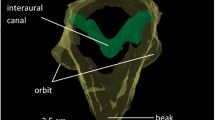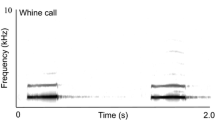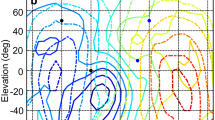Abstract
The barn owl, a nocturnal predator, derives its German name (“Schleiereule”, direct English translation “veil owl”) from the conspicuous ruff that covers the ear openings and gives the head a face-like appearance. The ruff is a specialization for the perception of sound. The densely-ramified reflector feathers forming the border of the ruff direct sound to the ear-openings. We studied the influence of the ruff on the behaviorally relevant sound-localization parameters interaural time difference (ITD) and interaural level difference (ILD). The directionality of the ear was much greater when the ruff was intact than when the reflector feathers were removed. With ruff intact, the distribution of ILDs was oblique and the maximum ITD occurred around 110° of azimuth. When all head feathers were removed, the steepest ILD gradient was much closer to the horizontal axis and ITD was maximal at 90°. Many effects were frequency specific. Thus, the ruff reflects some properties of the human pinna. However, by shifting the point where ITD becomes maximal beyond 90°, the ruff also introduces a break of the front–back symmetry of ITD.









Similar content being viewed by others
Abbreviations
- ITD:
-
Interaural time difference
- ILD:
-
Interaural level difference
- FFT:
-
Fast Fourier transformation
References
Bala AD, Spitzer MW, Takahashi TT (2003) Prediction of auditory spatial acuity from neural images on the owl’s auditory space map. Nature 424:771–774
Blauert J (1997) Spatial hearing. MIT, Cambridge
Brainard MS, Knudsen EI, Esterly SD (1992) Neural derivation of sound source location: resolution of spatial ambiguities in binaural cues. J Acoust Soc Am 91:1015–1027
Calford MB, Wise LZ, Pettigrew JD (1985) Coding of sound location and frequency in the auditory midbrain of diurnal birds of prey, families Accipitridae and Falconidae. J Comp Physiol A 157:149–160
Coles RB, Guppy A (1988) Directional hearing in the barn owl (Tyto alba). J Comp Physiol A 163:117–133
Dyson ML, Klump GM, Gauger B (1998) Absolute hearing thresholds and critical masking ratios in the European barn owl: a comparison with other owls. J Comp Physiol A 182:695–702
Egnor SER (2001) Effects of binaural decorrelation on neural and behavioral processing of interaural level differences in the barn owl (Tyto alba). J Comp Physiol A 187:589–595
Euston DR, Takahashi TT (2002) From spectrum to space: the contribution of level difference cues to spatial receptive fields in the barn owl inferior colliculus. J Neurosci 22:284–293
Gold JL, Knudsen EI (2000) Abnormal auditory experience induces frequency-specific adjustments in unit tuning for binaural localization cues in the optic tectum of juvenile owls. J Neurosci 20:862–877
Haresign T, Moiseff A (1988) Early growth and development of the common barn-owl’s facial ruff. The Auk 105:699–705
Heffner RS, Heffner HE (1992) Visual factors in sound localization in mammals. J Comp Neurol 317:219–232
Heffner RR, Koay F, Heffner HE (1996) Sound localization in chinchillas, III: Effect of pinna removal. Hear Res 99:13–21
Hofman PM, van Riswick JG, van Opstal AJ (1998) Relearning sound localization with new ears. Nat Neurosci 1:417–421
Keller CH, Hartung K, Takahashi TT (1998) Head-related transfer functions of the barn owl: measurement and neural responses. Hear Res 118:13–34
Knudsen EI (1999) Mechanisms of experience-dependent plasticity in the auditory localization pathway of the barn owl. J Comp Physiol A 185:305–321
Knudsen EI, Blasdel GG, Konishi M (1979) Sound localization by the barn owl measured with the search coil technique. J Comp Physiol 133:1–11
Knudsen EI, Konishi M (1979) Mechanisms of sound localization in the barn owl (Tyto alba). J Comp Physiol 133:13–21
Knudsen EI, Esterly SD, Olsen JF (1994) Adaptive plasticity of the auditory space map in the optic tectum of adult and baby barn owls in response to external ear modification. J Neurophysiol 71:79–94
Koch UR, Wagner H (2002) Morphometry of auricular feathers of barn owls (Tyto alba). Eur J Morphol 40:15–21
Konishi M (2003) Coding of auditory space. Ann Rev Neurosci 26:31–55
Konishi M (1973) How the owl tracks its prey. Am Sci 61:414–424
Middlebrooks JC (1992) Narrow-band sound localization related to external ear acoustics. J Acoust Soc Am 92:2607–2624
Moiseff A, Konishi M (1981) Neuronal and behavioral sensitivity to binaural time differences in the owl. J Neurosci 1:41–49
Moiseff A (1989a) Binaural disparity cues available to the barn owl for sound localization. J Comp Physiol A 164:629–636
Moiseff A (1989b) Bi-coordinate sound localization by the barn owl. J Comp Physiol A 164:637–644
Müller S Massarani P (2001) Transfer function measurement with sweeps. J Audio Eng Soc 49:443–471
Olsen JF, Knudsen EI, Esterly SD (1989) Neural maps of interaural time and intensity differences in the optic tectum of the barn owl. J Neurosci 9:2591–2605
Payne RS (1971) Acoustic location of prey by barn owls (Tyto alba). J Exp Biol 54:535–573
Poganiatz I, Nelken I, Wagner H (2001) Sound-localization experiments with barn owls in virtual space: influence of interaural time difference on head-turning behavior. J Assoc Res Otolaryngol 2:1–21
Poganiatz I Wagner H (2001) Sound-localization experiments with barn owls in virtual space: influence of broadband interaural level different on head-turning behavior. J Comp Physiol A 187:225–233
Populin LC, Yin TCT (1998) Behavioral studies of sound localization in the cat. J Neurosci 18:2147–2160
Rice JJ, May BJ, Spirou GA, Young ED (1992) Pinna-based spectral cues for sound localization in cat. Hear Res 58:132–152
Wagner H (1993) Lesion-induced sound-localization deficits in the barn owl. J Neurosci 13:371–386
Wightman FL, Kistler DJ (1989) Headphone simulation of free-field listening. I. Psychophysical validation. J Acoust Soc Am 85:868–878
Wightman FL, Kistler DJ (1999) Resolution of front–back ambiguity in spatial hearing by listener and source movement. J Acoust Soc Am 105:284–2853
Acknowledgments
We thank Frank Endler for help with programming. Eli Nelken and Iris Poganiatz supported us in an early phase of this project. We thank Catherine Carr and Eli Nelken for comments on an earlier version of this manuscript. Petra Nikolay made the drawings of the owl’s head. This research was supported by the DFG (Wa606/13).
Author information
Authors and Affiliations
Corresponding author
Rights and permissions
About this article
Cite this article
von Campenhausen, M., Wagner, H. Influence of the facial ruff on the sound-receiving characteristics of the barn owl’s ears. J Comp Physiol A 192, 1073–1082 (2006). https://doi.org/10.1007/s00359-006-0139-0
Received:
Revised:
Accepted:
Published:
Issue Date:
DOI: https://doi.org/10.1007/s00359-006-0139-0




